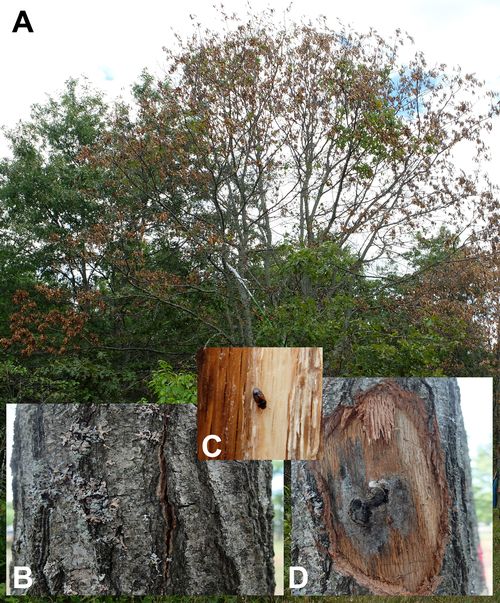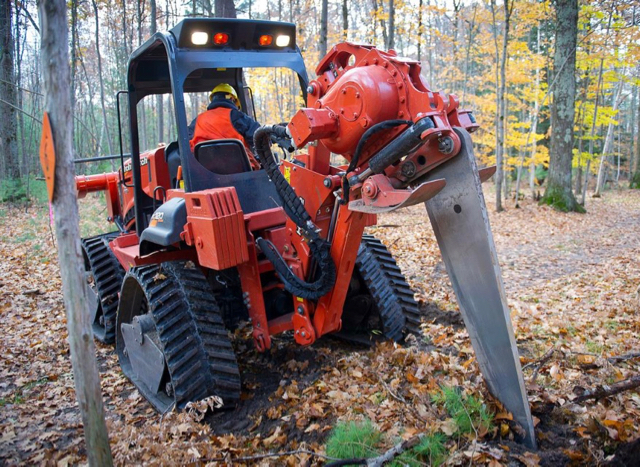MSU researchers at forefront of efforts to halt spread of oak wilt
Lab provides novel methods to protect trees against infection of deadly tree disease

EAST LANSING, Mich. – Michigan State University is on the frontlines of research and management efforts to stop the spread of oak wilt, a fungal disease that has killed thousands of oak trees across the state, impacting more than 70% of Michigan’s counties.
Oak wilt is particularly deadly to red oaks, which include pin, black and northern red oaks. Oaks comprise 10% of the forest acreage in Michigan (with an estimated 149 million standing trees). Michigan’s red oak timber is valued at an estimated $1.6 billion.
Oak wilt is a serious threat to Michigan's forests, woodlots, parks, suburban neighborhoods, and urban properties. Once established, if not managed, oak wilt will continue to spread, killing all red oaks in the surrounding neighborhood or forest.
MSU AgBioResearch scientists Monique Sakalidis (Department of Plant, Soil and Microbial Sciences and Department of Forestry), Deborah McCullough (Department of Entomology and Department of Forestry) and Bert Cregg (Department of Horticulture and Department of Forestry) lead the MSU oak wilt response team. Through collaborative research and outreach programming, they have expanded our knowledge on the biology and epidemiology of oak wilt and continue to work on improving diagnostic techniques and treatment methods for this disease.

“It’s exciting for me to be able to work at the intersection of fundamental and applied research, understanding more about the pathogens I work with, but also finding solutions and making a difference in people’s lives,” said Monique Sakalidis, whose lab helped refine the key risk periods for overland spread of this deadly disease.
Since trees cannot be saved once infected, management is geared towards preventing new infections.
“We looked to see when trees were most susceptible to infection, when was the oak wilt fungus producing spores and working with the McCullough lab we looked to see when beetles were becoming contaminated with the spores. We found the time that that all three (peak tree susceptibility, peak spore production and peak contaminated beetle activity) occurred overlapped, with the most risk of overland oak wilt spread and infection occurring in May and June each year,” Sakalidis said. “Through MSU Project GREEEN and the Michigan Invasive Species Grant Program, we have been able to develop integrated research-extension projects with the ultimate goal of reducing the number of trees becoming infected with the oak wilt fungus. This is critical because once trees are infected they cannot be cured.”
Efforts are tailored to localized management needs based on partnership with the state’s arborists, MSU Extension specialists, Michigan Department of Natural Resources, Michigan Department of Agriculture and Rural Development and the U.S. Forest Service.
“I work with our folks on the ground involved in tree care, tree health and tree-growing industries to find out how they are currently managing diseases and to better understand the needs that inform our research priorities. This ensures I am finding solutions to tree disease issues that are having the greatest impact in Michigan and the Midwest,” Sakalidis said.
Michigan's forest products industries generate $13.4 billion in economic output and support diverse industry with approximately 150 registered foresters, 800 logging and trucking firms, 1,300 primary and secondary manufacturers. More than 200,000 jobs are annually supported statewide through forest-based industries and tourism/recreation.
Sakalidis coordinates with MSU Plant & Pest Diagnostics to conduct rapid screening and response to emerging tree disease pathogens.

“We work on diseases that are affecting Michigan trees and Michigan tree industries,” Sakalidis said. “The research that we do supports the needs of our extension communities and I work hand-in-hand with them from diagnosing new disease issues to finding solutions to manage emerging and established diseases. Sometimes this involves developing a research program and other times this outreach and education.”
Sakalidis is examining novel and enhanced methods to isolate and remove oak wilt infected trees from an otherwise healthy environment. The current best practice requires use of a vibratory plow with a five-foot blade to cut through and disrupt tree root systems between diseased and healthy trees.
“We received feedback from arborists and community members that while very effective, this process is expensive, and cannot be implemented in some cases due to specific landscape features or the presence of underground utilities, so an alternative to mechanical root disruption is needed,” Sakalidis said.
Sakalidis currently has Project GREEEN and Michigan Invasive Species Grant funding to examine the effectiveness of using herbicide to limit the underground spread of oak wilt, instead of requiring a plow to destroy the root systems.
 “Vibratory plow treatments are cost prohibitive for a lot of landowners, so an herbicide treatment could be something they could more easily implement,” said Simeon Wright, Michigan Department of Natural Resources forest health specialist. “Making oak wilt treatment more accessible will encourage more landowners to adopt treatment plans, which ultimately reduces the risk of oak wilt infection throughout the state.”
“Vibratory plow treatments are cost prohibitive for a lot of landowners, so an herbicide treatment could be something they could more easily implement,” said Simeon Wright, Michigan Department of Natural Resources forest health specialist. “Making oak wilt treatment more accessible will encourage more landowners to adopt treatment plans, which ultimately reduces the risk of oak wilt infection throughout the state.”
More than half of Michigan’s 19.3 million forest acres (Michigan ranks fifth largest nationally in timberland), are privately owned, 2.6 million are federally-owned (U.S. Forest Service), and the remaining 4.4 million acres are owned and managed by the state.
Sakalidis and Wright partner to implement and communicate oak wilt infection prevention methods to arborists and landowners across the state. Through scouting programs on public and private lands and diagnostic networks across the state comprised of MSU Extension personnel, MSU Plant & Pest Diagnostics, state and federal specialists and professional arborists across Michigan, researchers identify oak wilt infection and respond with management efforts aimed at isolating infected trees and preventing spread of the fungus to neighboring healthy trees.

Working alongside McCullough, professor of Forest Entomology, the MSU Oak Wilt Team discovered seasonal variations of when trees are most likely to be infected through interaction with sap beetles. This discovery allowed for management guidelines to be implemented to reduce the chances of tree interactions with disease vectoring beetles.
“To be able to define that high-risk period when infection is likely to occur through tree wounds is really important to us, because that directly impacts management of harvests or other activities that could potentially result in the wounding of oak trees,” Wright said. “We want to make sure that we're not harvesting or damaging trees at a time when oak wilt infection is likely to result. MSU research has allowed us to identify more precisely when that high-risk period is, so that we only have to place restrictions when they are critically needed and can eliminate responses that are not needed.”
To ensure arborists across the state are equipped with the latest information on prevention and treatment of tree diseases, MSU partners with ISA Michigan, a chapter of the International Society of Arboriculture.
ISA Michigan is the state association for tree-care professionals. As a nonprofit organization, it represents arborists, urban foresters, municipal and utility foresters, professional tree workers/climbers, academia and others interested in all aspects of arboriculture and the health and care of Michigan trees.

“MSU’s support is fundamental to what we do as an organization,” said Annie Kruise, executive director of ISA-Michigan. “We wouldn't be able to provide the level of education and professional awareness of tree issues and treatments in the state if we did not have our connection to MSU and its researchers.”
MSU tree experts are frequent speakers and educators at ISA Michigan events, including ArborCon - the annual premiere tree care conference and trade show in Michigan. ISA Michigan developed and facilitates the Oak Wilt Identification and Management Qualification Course, providing industry professionals in-depth oak wilt training to effectively prevent, diagnose and treat oak wilt on various landscape scales.
The Oak Wilt Coalition is a partnership between private, nonprofit and governmental organizations, including representatives from MSU, Michigan Departments of Transportation, DNR and MDARD, ReLeaf Michigan, Michigan Forest Association, Michigan Green Industry Association, electric utilities, private companies and others.
Oak wilt threatens new species
In October 2022, the MSU Oak Wilt Team and MSU Plant & Pest Diagnostics assisted in the key discovery of the oak wilt pathogen in chestnut trees.
“One grower alerted us that they had observed one tree death in 2021, then an additional 15 trees died in 2022, with tree death occurring within 10 days of symptom development,” Sakalidis said. “Michigan is experiencing an oak wilt epidemic, with the disease present in red oak in the majority of Michigan counties, we are currently at the epicenter of the oak wilt issue. In addition to our vast red oak population, Michigan also has the highest acreage of commercial chestnut production in the U.S., so this discovery is of huge concern.”
Previous official reports of oak wilt in chestnut trees had been reported in Chinese chestnuts in commercial orchards in the U.S. in 1950, Sakalidis said.
Sakalidis recently was awarded Project GREEEN funding to begin exploration of best practices to apply already successful oak wilt solutions to find short-term and long-term solutions to immediately begin work on addressing oak wilt threats to chestnuts.
Even more alarming, she said, is the limited evidence showing chestnuts are dying within 10 days of grower-reported infection; red oaks generally die within six weeks of infection, presenting “a huge concern, because the pathogen could be moving on to agricultural trees used as food crops in an orchard environment. That’s a different kettle of fish to treat as opposed to maybe diseased trees in the forest.”
As tree diseases evolve, detection methods improve and Michigan’s forests and arborists continue to encounter chronic and emerging tree diseases. Sakalidis and her MSU team hope to continue to build networks within the state to more quickly and efficiently scout, diagnose and manage oak wilt disease.
“Part of what I'm trying to develop in my lab is a pipeline of information, so if there is something new, we have a series of steps we can take to quickly say, ‘hey, this is what it is and based on the characteristics of this disease we know what we can do next,’ or ‘we don’t yet have the answers, and this is the research that is needed to find a solution,’” she said.



 Print
Print Email
Email




